Let's practice heatstroke prevention behavior
Every year, many health hazards due to heat stroke are reported, and it is important for each and every one of us to take measures to prevent heat stroke in preparation for the hot season when the temperature is high.
Regarding the new coronavirus infection, it is necessary to continue to take basic infection control measures, but wearing a mask in a hot and humid environment in summer may increase the risk of heat stroke. Let's practice heat stroke prevention actions based on measures against the new coronavirus infectious disease, and be careful of heat stroke more than usual.
Points to prevent heat stroke based on measures against new coronavirus infectious diseases
1: Wearing a mask
While masks are effective in preventing the spread of droplets, the risk of heat stroke increases in hot and humid environments.
To prevent heat stroke, remove your mask outdoors, except when talking at a short distance (within 2 meters). For example, when commuting to work or school on foot or by bicycle, or when exercising such as walking or running, remove the mask during outdoor activities.
Please use air conditioners, fans, and ventilation indoors to avoid the heat and take measures against infectious diseases. You don't need to wear a mask if you can keep your distance from people indoors and rarely talk to each other.
2: About the use of air conditioners
The use of air conditioners is effective in preventing heatstroke. However, general household air conditioners only circulate air and do not perform ventilation. In order to prevent the spread of the new coronavirus, it is necessary to ventilate by opening windows and using ventilation fans even when it is air-conditioned. The indoor temperature tends to rise due to ventilation, so adjust the temperature setting of the air conditioner, etc.
3: About moving to a cool place
If you feel even the slightest change in your physical condition, immediately move to a cool place. Move to a cool place, such as an air-conditioned room or a well-ventilated shade.
Avoid going out during hot weather, wear a parasol, hat, and cool clothes.
4: About hydration
Whether you're indoors or out, stay hydrated even if you don't feel thirsty. Please drink 1.2 liters (about 6 cups of glass) per day as a guide, and rehydrate before and after bathing and after waking up. Don't forget to take salt when you sweat a lot.
5: About daily health management
Take your body temperature and check your health at regular times, such as every morning, and know your body on a daily basis and manage your physical condition. By knowing your normal temperature, you can also notice a fever early. If you feel unwell, do not overdo it and rest at home.
You can prevent heat stroke!
Heat stroke can be prevented by each person having correct knowledge
Please be careful of heatstroke! [Yasashii Nihongo] page
Heat stroke occurs when the body's water-salt balance is disrupted in a hot place, or when the body's regulatory functions do not work properly. It occurs in a wide range of age groups, not only outdoors, but also indoors and at night. On hot and humid days, avoid unreasonable power saving and use fans and air conditioners moderately.
◆ Heatstroke can be prevented if you know how to prevent it, and you can save your life if you know first aid◆
In collaboration with the "Heat Stroke Prevention Call Project," Osaka City has held events to distribute heat stroke countermeasure drinks, paper fans, and pamphlets with prevention methods. We are working to raise awareness of
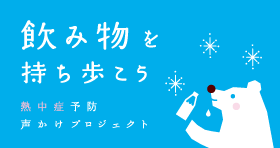
*Bring your drink*
Staying hydrated is key to preventing heatstroke.
Carry your drink with you so you can stay hydrated anytime, anywhere.
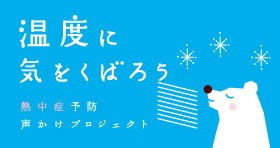
*Keep an eye on the temperature*
Be sensitive to heat.
The heat you feel on your body and the actual temperature may differ.

*take a rest*
Don't work too hard in the summer.
It is easy to get heatstroke when you are tired, so take a rest.
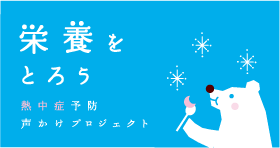
*Nutrition*
Eating properly also helps prevent heat stroke.
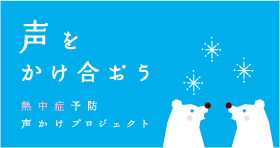
*call out*
Elderly people and children who do not have physical strength are more susceptible to heat stroke.
Let's spread the circle of voices.
Osaka heat index
The Ministry of the Environment provides information on the heat stroke prevention information site for the predicted and actual values of the heat index for 841 locations nationwide.
You can check the heat index of Osaka from here ⇒Ministry of the Environment heat stroke prevention information site
* What is the heat index?
1. Humidity 2. Surrounding thermal environment such as solar radiation and radiation 3. It is an index that incorporates three above the temperature . It was proposed in the United States in 1954 for the purpose of preventing heatstroke.
Have a thing that I want to ask for
How the heat feels varies from person to person!
- Resistance to heat (sensitivity) varies from person to person, influenced by physical condition and habituation to heat.
- Be aware of changes in your physical condition and take all possible precautions according to your resistance to heat.
Elderly people need special attention!
- Approximately half of heatstroke patients are elderly people aged 65 and over. The ability to sense heat and dehydration is reduced, and the body's ability to adjust to heat is also impaired.
- Even if you don't feel thirsty, remember to drink water frequently, and use fans and air conditioners to adjust the temperature even if you don't feel the heat.
Consultation desk about heat stroke
Main symptoms of heatstroke
It is important to take measures such as paying attention to slight symptoms (signs) and preparing the environment.
| severity | symptoms | measures |
|---|---|---|
| Severity 1 |
・Dizziness or dizziness when standing up. |
Evacuate to a cool place Loosen your clothes and cool your body Replenish water and salt |
| Severity 2 | ・Headache ・Nausea, vomiting ・Malaise, fatigue | Evacuate to a cool place Loosen your clothes and cool your body Replenish water and salt Elevate your feet and rest |
| severity 3 | ・Lack of consciousness ・Convulsions that occur in the body ・The answer to the call is strange ・I can't walk or run straight ・I have a high body temperature |
Call an ambulance immediately! Use ice or water to cool the neck, armpits, groin, etc. |
Is it heat stroke? If you think
-
Evacuate to a cool place
Evacuate to a well-ventilated shaded area or, if possible, a room with an air conditioner. -
Help the heat escape from the body by having them remove their clothes , any cooling clothing they may have.
Cool the body by pouring water over the exposed skin and fanning it with a paper fan or fan.
If you have an ice pack, it is also effective to apply it to the nape of the neck, armpits, groin, and hip joints. (It has the effect of cooling the flowing blood where thick blood vessels run just under the skin.)
It should be cooled as quickly as possible. The ability to save the life of a seriously injured person depends on how quickly they can lower their body temperature.
Even after requesting an ambulance, it is important to start cooling before the ambulance arrives. If the core body temperature exceeds 40°C, symptoms such as generalized convulsions (convulsions) and blood coagulation disorders (blood coagulation failure) may appear. -
Replenishment of water and salt
Cold drinks draw heat away from the surface of the stomach. Sports drinks and oral rehydration solutions are the best options when you sweat a lot. Salt water (1 to 2 g of salt per liter of water) is also effective.
If they are responsive and alert, give them plenty of cold water to drink. However, if the patient reacts strangely to calls or stimuli or does not respond (disturbance of consciousness), fluid may accidentally flow into the respiratory tract. Also, the symptoms of "sue nausea" or "vomit" are evidence that the movement of the gastrointestinal tract has already slowed down. In these cases, never give water. I need a drip in the hospital. -
take to a medical institution
If the person is unconscious and unable to take fluids on their own, it is necessary to replenish fluids with an IV. The first priority is to transport the patient to a medical institution in an emergency.
In fact, nearly half of heatstroke cases are of severity 3 or 2, requiring infusion (intravenous fluid administration) and strict management (monitoring of blood pressure and urine output, etc.) at medical institutions. .
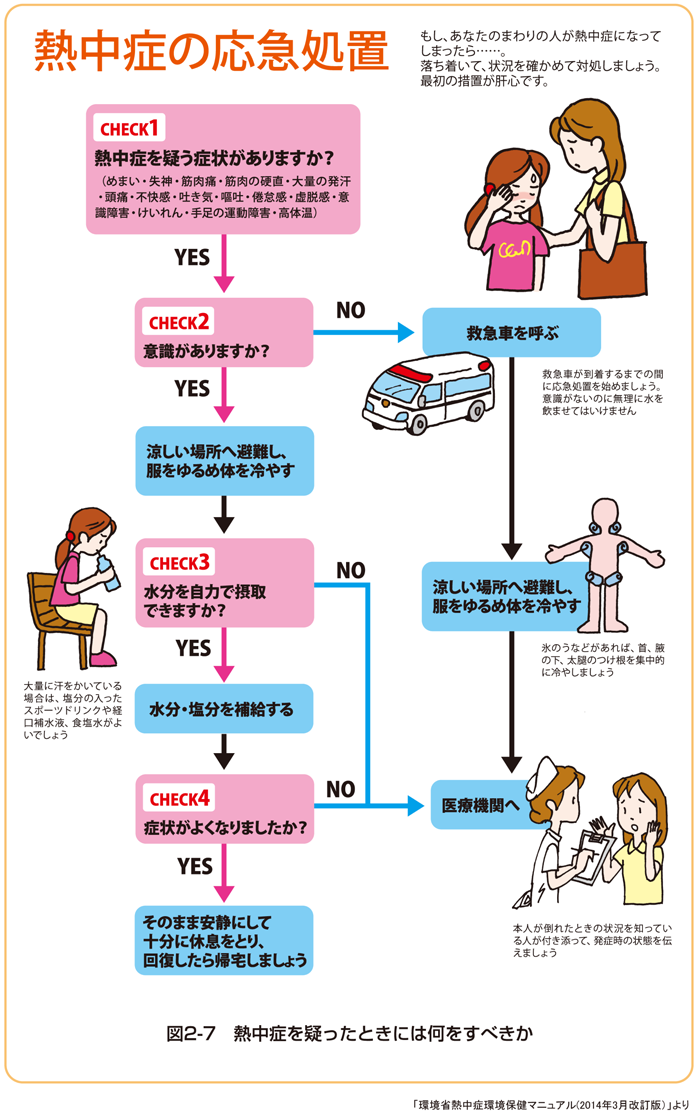
Link about heat stroke
-
[Osaka City Fire Department] Learn preventive first aid through animation
Introducing how to prevent heat stroke in an easy-to-understand video
-
[Ministry of the Environment] Heat Stroke Prevention Information Site
Heat index, heat stroke prevention and coping methods, heat countermeasures, etc.
-
[Japan Meteorological Agency] To protect yourself from heat stroke
Temperature forecast information, weather forecast, temperature observation information, etc.
-
[Ministry of Health, Labor and Welfare] Information and materials site for heat stroke prevention
Other things you should know to prevent heat stroke
-
[Ministry of Health, Labor and Welfare] Information related to heat stroke
Leaflets in four languages, leaflets for people with disabilities, etc.
-
[Ministry of Health, Labor and Welfare] "Let's drink water for health" promotion campaign
A campaign to "drink water for health and protect precious human lives from serious accidents such as heat stroke and cerebral infarction" has been widely spread across the country. Posters, leaflets, basic information on water and health, etc.
-
[Ministry of Health, Labor and Welfare] Measures to prevent heat stroke in the workplace
Workplace heatstroke prevention manual, etc.
-
[Fire and Disaster Management Agency, Ministry of Internal Affairs and Communications] Information on heat stroke
Status of emergency transportation due to heatstroke (changes by week), etc.
Leaflet for heat stroke prevention enlightenment
 Leaflet for children and infants (PDF format, 334.52KB)
Leaflet for children and infants (PDF format, 334.52KB) Leaflet for the elderly (PDF format, 471.15KB)
Leaflet for the elderly (PDF format, 471.15KB)
-
 CC (Creative Commons) License
CC (Creative Commons) License CC-BY4.0 in
will be provided.
 Download Adobe Acrobat Reader DC (free)
Download Adobe Acrobat Reader DC (free) - If you cannot view PDF files, download Adobe Acrobat Reader DC (free) from the Adobe website.
About heatstroke prevention calling project
The Ministry of the Environment and the public and private sectors are working together to disseminate correct knowledge about heat stroke. Let's take a break, take a rest, eat nourishment, and talk to each other).
Find similar pages
I can't find the information I'm looking for
Creator of this page and contact information
Health Policy Division, Health Promotion Department, Health Bureau Phone: 06-6208-9951 Fax: 06-6202-6967
Address: 1-3-20 Nakanoshima, Kita-ku, Osaka 530-8201 (Osaka City Hall 2F)




